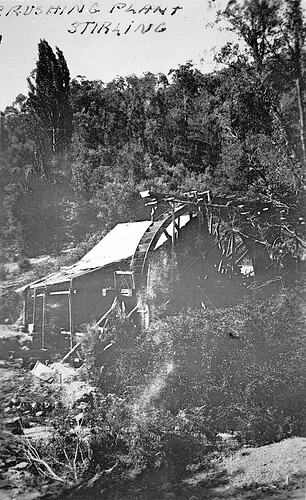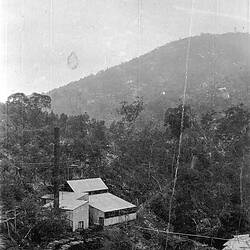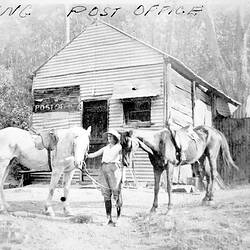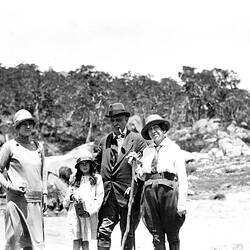Summary
Stirling was a small mining settlement on the Haunted Stream goldfield situated in rugged mountain country between Bairnsdale and Omeo. Alluvial gold had first been discovered in the area in 1863, causing a small rush that soon petered out. The discovery of several rich quartz reefs between 1882 and 1884 led to a revival, with the expanding settlement formed near the junction of Tierneys Creek and the Haunted Stream being named Stirling in 1889, in honour of the government geologist and surveyor, James Stirling (1852-1909), who had done much to assist the development of mining prospects throughout the district. Stirling had arrived in the Omeo district in 1877, working initially as a surveyor and foreman with the Crown Lands Department, before transferring to the Mines Department as an Assistant Geological Surveyor in April 1887. The town soon boasted two hotels, a wine saloon, boarding houses, a general store, butcher, baker, billiard room, post office, police station, recreation ground and Mechanics Institute Hall - which doubled as a schoolroom and church. The Haunted Steam State School (No.2845) opened in October 1887 and had an average attendance of 15 pupils throughout its first two decades.
The formation of the Stirling Proprietary Gold Mining Co. (No Liability) in 1898, marked the beginning of an era of renewed interest in quartz mining on the Haunted Stream goldfield, with new capital flowing from investors in Melbourne, Ballarat and Bendigo, and the establishment of over a dozen new mines. As mining activity extended up the winding valley, another settlement was established in 1902 near Sheepstation Creek, about 10 miles (16 kms) upstream of Stirling. It was named Dawson City after its far more populous namesake, which in the late 1890s had become world-famous as the epicentre of the Klondike goldfield in Canada's Yukon Territory, being the destination of the last great international goldrush of the 19th century.
Around Dawson City on Haunted Stream, a small cluster of quartz mines developed, operated mainly by co-operative parties and private partnerships, including the Stirling King, Secret, West Secret, Happy Moments and Star of Stirling G.M. Association. Alex Lamb, a Ballarat-based stockbroker and mining investor, was reported in 1902 to be installing a water-powered 6-head stamp battery to undertake public crushings, and for almost a decade the mines thrived, treating mainly small parcels of hand-picked high-grade ore. By 1912, however, mining on the Haunted Stream goldfield was in an 'unusual depression' from which it would never recover, leaving the settlements of Stirling and Dawson City in terminal decline. The State School moved to a part-time teaching basis in 1914 and soon afterwards the post office was also closed. By 1916, only three small co-operative mining parties were still active on the field making 'a fair subsistence' from prospecting and picking over former workings, taking advantage of water-power milling machinery that could be operated at minimum expense. By December 1918 it was reported that the townships of Stirling and Dawson City had 'practically passed into oblivion', with only three families still residing in the valley. After a limited revival in prospecting during the 1930s depression, the Haunted Stream Mining Division was abolished in May 1936, with the area it had encompassed being absorbed into the adjoining Mitchell River Mining Division of the Gippsland Mining District.
Description of Content
View, looking northwards, towards a small water-powered quartz crushing plant on the Haunted Stream goldfields in Gippsland. At the near end of the building is a wooden framed overshot waterwheel estimated to be about 15 to 18 feet in diameter (4.5 - 5.4 m). An elevated timber flume extends from the right-hand side of the image to the top of the wheel and would have been connected to a water race diverting water from the stream further up the valley. The building has the distinctive form of a stamp battery house with a central high gable and a wide open-sided skillion-roofed 'lean to' at the front, and from its size, was probably built to house a small battery of 5 to 10 stamp heads. A timber tailings shoot or sluice box extends from the front of the battery house discharging into a the stream bed or bank of a watercourse strewn with rocks and small boulders. In the background is a clearing with a backdrop of both eucalypts and deciduous trees (poplars?). It is not know which of the nine stamp batteries on the Haunted Stream goldfield is depicted in this image, however, there were a number small water-powered stamp batteries throughout the valley, which were made available for hire to small co-operative parties and privately own mines.
More Information
-
Collection Names
-
Collecting Areas
-
Acquisition Information
Copied from E. J. Conn, 09 Nov 1987
-
Place & Date Depicted
Stirling, Haunted Stream, East Gippsland, Victoria, Australia, 1911
-
Format
Negative, 35 mm, Black & White
-
Inscriptions
Handwritten in black, across top of photograph; "CRUSHING PLANT / STIRLING"
-
Classification
-
Category
-
Discipline
-
Type of item
-
References
In a letter to the Weekly Times, published in August 1915, former resident Edwin J. Conn recalled earlier life in the township of Stirling:
"SOMETHING ABOUT STIRLING. Edwin James Conn, who lives at Tambo Crossing, writes:- Dear Uncle Ben.- The place we lived in was Stirling. There used to be a lot of mines there, but here are only two working now. The ones that are working are doing very well. The last crushing was 84 ounces from 50 ton of stone. The other claim went 27 ounces from 20 ton of stone. There were nine batteries there a long time ago. One time there were hundreds of people. There were two hotels, three stores, and several boarding houses, a butcher's shop, a library, and a State school; now there are very few people living there, and no business places at nil. Supplies come from Ensay, a distance of over 23 miles. I am eight years and 10 months old. Please may I write again? (Yes. Edwin, you may write again -Uncle Ben)."
'Something About Sitrling', Weekly Times (Melbourne), Sat 21 Aug 1915, p.37, [Link 1]
-
Keywords
Battery Houses, Deciduous Trees, Forests, Gold Mining, Mining Equipment, Mountains, Ore Treatment Works, Quartz Crushing Machinery, Quartz Mining, Stamp Batteries, Water Flumes, Water Power, Water Wheels, Star Clusters, Celestial Bodies




